Follow Me
Latest Posts
- Cool, Sustainable Packing and Shipping Solutions for Earth Day
- Paper Doll Shares How To Select a Shredder, Shred Responsibly, and Save
- Paper Doll’s Ultimate Guide to Tax-Smart Organizing: 2024
- Paper Doll Explains Aspirational vs. Inspirational Clutter
- Paper Doll Shares 3 Quirky & Cool New Office Supplies
Search Best Results Organizing
Subscribe to the Paper Doll Blog via Email
Paper Doll Shares How To Select a Shredder, Shred Responsibly, and Save
Posted on: April 8th, 2024 by Julie Bestry | 14 Comments

Much of the following post originally appeared in 2021 and has been updated for 2024 with current product links and shredding discounts.
Klop. KaKLOP! Klunkety klunkety. KaKLOP! Grrrrrr uggggggg. KaKLOP!
No, unlike the officer at U.S. Strategic Command (STRATCOM), I haven’t let a tiny human take over my keyboard. The above is a close approximation of the sound my shredder made last weekend when, after two decades of faithful service and about halfway through shredding documents no longer necessary for tax time, it gave up the ghost.
At first, I thought I might have just fed one too many staples into the grinding teeth of my little document destruction devil. But, when I lifted the shredder from the bin and turned it over, nothing was stuck in the teeth. However, as I shifted the up-ended shredder motor from my left hand to my right, I could hear something sliding back and forth within. Ruh-roh!
Far more curious than mechanically inclined, I took a screwdriver to the whole housing unit, wondering if I might be able to just stick something back in place. (Yeah, go ahead and laugh.) Sadly, I found that a large octagonal metal washer (for want of a better description) had broken completely in half. The wheels on this bus were NOT going to go round and round any longer. I had to buy a new shredder.
DIY SHREDDER ESSENTIALS
Although I haven’t had to purchase a shredder in a long time, this is not my first shredding rodeo. Many of my clients find themselves either buying a first or replacement shredder as part of our work when we’re organizing and purging paper. So at least I knew what I needed to consider.
I hate to be crude, but size matters: the size of your shredder unit, the size of your “shreds,” and the size of the pile (or capacity) you can shred at one time.
Shredder Unit Size
There are three general sizes/types of shredder units: mini, medium, and heavy-duty.
Don’t buy a mini.
Yes, I know, regular readers of this blog recognize that I rarely invoke absolutes; the world is far more grey than black-and-white. However, unless you are buying a shredder for a child, I want to discourage you from buying a mini, or desktop, shredder.

I admit, most “desktop” shredders are not hand-cranked and adorable like the one above. Indeed, most are more like the Aurora AS420C Desktop Style Cross-Cut Shredder below, in that it looks spiffy. But looks can be deceiving.

Often, I find that clients purchase desktop mini-shredders hoping that the small profile and easy desktop access will incline them toward keeping up with their shredding. However, the opposite is true.
Tiny shredders like the Aurora above only take four sheets at a time (vs. 8 or 12 for a more serviceable shredder), fed through its 4-1/2-inch “throat,” or feeder slot. As most mail is 8 1/2-inches wide, anything not already folded into halves or thirds will need to be folded before fed.
If you’ve got a multi-page credit card or utility bill (AmEx bills are usually a ridiculous number of pages, for example), you’ll have to separate the bill and feed just a few pages at a time. And the entire shredder can only accommodate 40 sheets, meaning you’ll have to repeatedly empty the basket. You’ll likely dread the prospect and avoid the task.
You may not ever need to power-shred, but mini- or desktop shredders just aren’t designed for the kind of paper that the average household, and especially the home-based office or actual office, needs to destroy. I‘ve said it before: A mini-shredder is a lot like an Easy-Bake® Oven. Yes, it can do what it promises, but would you cook Thanksgiving dinner without a full-sized oven?
Paper Doll Shares How To Select a Shredder, Shred Responsibly, and Save Click To TweetFor typical home use, and for one-person offices, a medium-sized shredder should suffice. It should be able to handle four to six gallons of shredded paper (or about 150 to 400 sheets).
If you work in a large office, particularly one that deals with medical paperwork (covered by HIPAA regulations) or client financial information, you will want a shredder designed for large-capacity, heavy-duty shredding, one with an eight-gallon or larger basket/bin and the ability to shred for much longer without the red-light-of-doom. (You’ll also be looking at a shredder that costs many hundreds of dollars, rather than one in the $30-$150 range.)

Shred Size and Shape
There are generally three types of shred sizes produced by consumer shredders. (Industrial shredders can pulverize paper into a fine dust, but that might be going overboard for destroying old bank statements.) These are known as strip-cut, cross-cut, and micro-cut.
Shockingly, I have another absolute for you: don’t buy the old-style strip-cut shredders; they’re rarely sold anymore, but even if you see a good deal at a garage sale, pass it by. Strip-cut shredders offer poor identity theft protection if someone really wants to get their hands on your data.
You will want a cross-cut or micro-cut shredder. A cross-cut shredder reduces your paper to 1-inch to 1-1/2-inch squiggly strips; such shredders are considered secure or “medium-security” and are rated P4 or P3 security levels, respectively. On average, a cross-cut shredder shreds paper into 200 pieces (for a P3-rated shredder) or 400 pieces (for a P4-rated shredder). At home or in a one-person office, a cross-cut shredder will suffice.
A micro-cut shredder chops paper into tiny fragments; micro-cut shredders are rated P5, P6, or P7 (the latter is also called nano-cut, and recommended for government and classified documents) in terms of security levels, shredding papers into 2000, 6000, or 12,000 pieces, respectively.
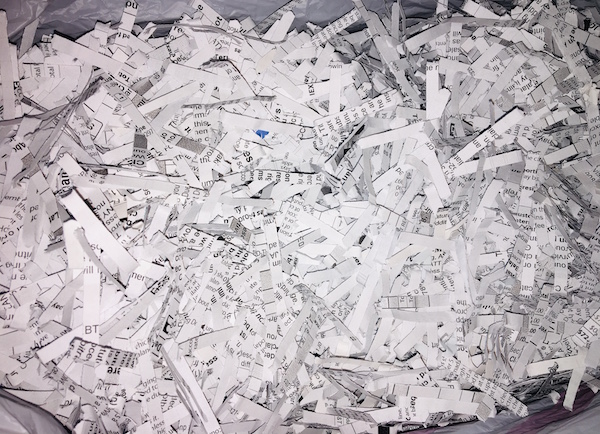
For an office that deals with HIPAA compliance, financial data, or spycraft, consider a micro-cut shredder. However, this is going to be over overkill (in terms of both function and cost) for use in a home office. (I mean, unless you’re a work-from-home spy, in which case…cool, dude!)
Capacity
There are three aspects to consider when looking at the capacity of a shredder:
1) How many sheets of paper can you feed at one time?
Most shredders you’ll be looking at for home use will be listed as handling 5-10 sheets at a time; for an office, a capacity of 10-18 sheets can be fed at one time. (There’s some cross-over in the home and office categories.) Bear in mind that at the home level, staples and thicker paper can reduce the number of sheets that can be safely fed at one time.
Heavy-duty shredders designed for office use can accommodate anywhere from 13 to 38 sheets at a time, with those at the higher level being much pricier. (That said, remember that shredders are office equipment and can be tax deductible for business use.)
While shredders are generally rated by the number of sheets shredded simultaneously, Paper Doll believes many manufacturers are a bit too optimistic in self-reporting. Just aim for the highest capacity shredder in your budget range.
2) How long can you shred before the shredder conks out? (This is called the shredder’s duty cycle.)
Ever get the red-light-of-doom while you’re shredding? This is the “Do not pass GO, do not collect $200!” message that means your shredder needs to cool down. Promotional materials usually claim that smaller shredders for home use can operate for two-to-three minutes continuously before needing a 20-to-30 minute break.
That doesn’t seem like very much time, but recognize that if you’ve got your shredder set to “on” rather than “automatic,” the shredder is only operating while you are pushing papers through. So, skip the automatic setting, take a few seconds between each multi-page pile of papers, and you’ll be OK for getting a bit more use.
Shredding companies have started listed their duty cycles on promotional material, but official capacity and real-world usage can be at odds, so do read the reviews.
3) What else can your shredder accommodate besides paper?
Any shredder you acquire should be able to handle stapled papers and (expired) credit cards. (Seriously, when you get your new credit card, make sure you put it somewhere away from the shredder and double-check the expiration date on the one you’re about to shred. I’ve heard from too many clients that they’ve oopsied this.)
Most should also be able to shred CDs and DVDs, but if you have a lot of data on disk, be sure to check that your intended purchase can accommodate what you need to shred.
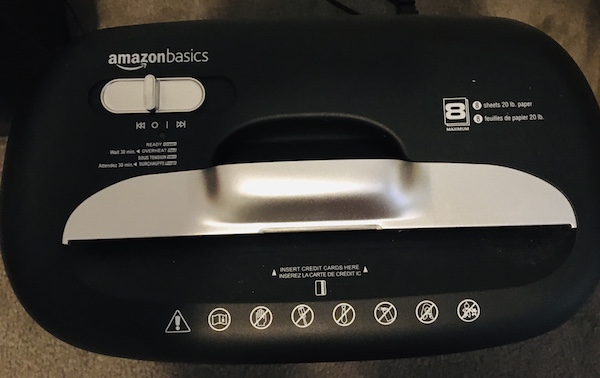
Other Considerations
Aesthetics — Unlike cell phones and other modern electronic devices, nobody seems to have given any thought to whether a shredder is attractive (to the eye or to the ear). I have yet to see a useful shredder in designer colors, and you’re pretty much limited to combinations of black and silver.
Obviously, design shouldn’t be your main concern, but you are likely to avoid using an ugly shredder or one that screeches. (Remember The Great Mesozoic Law Office Purge of 2015? When we cleaned out my father’s law office, he had an ancient, “yellowing” beige shredder. It was capital-U ugly, but Paper Mommy needed a shredder and was convinced she’d make use of it. Yeah. No.)
With regard to sound, whenever possible, test a friend’s shredder or ask a sales associate to help you test a floor model. The noise a shredder makes won’t exactly be pleasant, but some have more vibration or grinding than others. In another “you get what you pay for” instance, high capacity shredders make a smoother, less grind-y noise.
Ease of Use — The main concerns are an adequate-width feeder and an easy-to-empty basket or bin. The nicest shredders have a removable bin that slides out like a drawer or tips out like a laundry chute, but these tend to be more expensive than the budget versions, where the shredding mechanism lifts up and off to reveal a metal or rubber receptacle.
Avoid the low-rent shredders that only provide a mechanism to set atop a trash can; these are usually ill-fitting, poorly balanced, and lead to a flurry of shreds on your carpet, which furry animals and tiny humans will spread far and wide.
Special features — Some shredders, particularly those designed for a communal workspace, market special features at a higher price. For example, Fellowes markets a “100% Jam-Proof” micro-cut shredder upwards of $3100! And shockingly, it doesn’t even come with the hunky office worker pictured below!
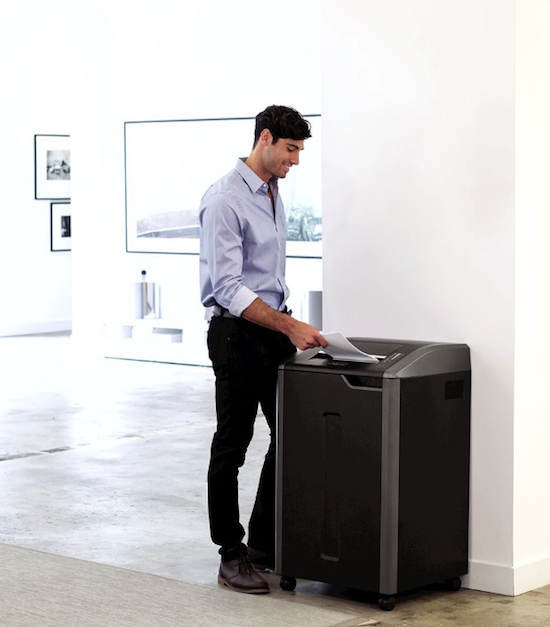
Others promote energy savings and quiet operations. As always, consider how often you’ll be using your shredder to determine how much extra you are willing to pay for special features.
At the lower end of the scale, you may want to consider the basket or bin into which you shred. The bin for my old shredder, the one that bit the dust, was made of metal mesh, which meant that a lot of the shredding dust poured into the air if I didn’t use a bag, but when I used a bag, I couldn’t tell when it was almost full.
Further, most shredders are designed so that the shredding unit/lid won’t fit properly into the bin if you’ve lined it with a bag, and if they do, most grocery-style plastic bags are smaller than the bin, so you’re not able to use your full capacity.
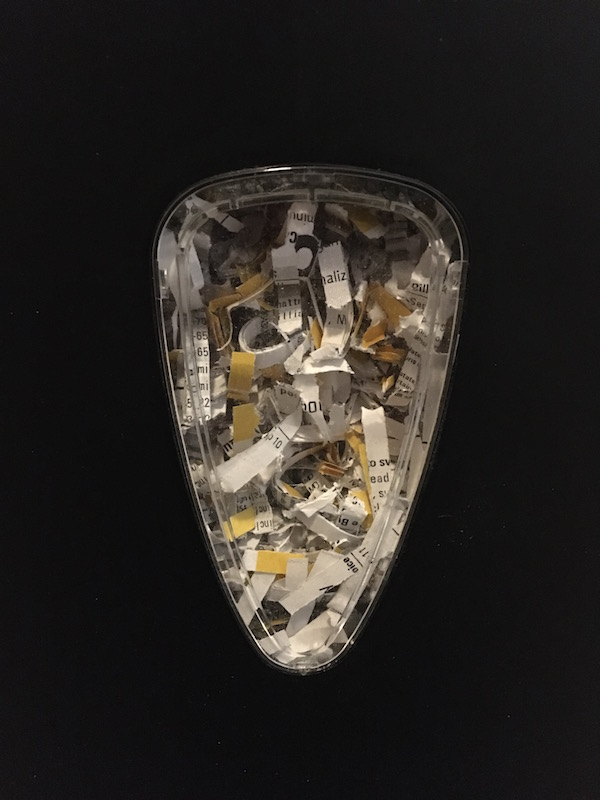
The front window in my cute new shredder
My new purchase warns not to use a bag; however, the base is made of a solid plastic (much like a trashcan) so there’s no shred dust plume, and has a nice window to give me a sense of when I’m about to reach maximum capacity. At that point, I must carefully lift up the shredding unit, tilt and flip it quickly to avoid spreading bits of shreds everywhere, and then I can upend the whole bin into the trash.
I prefer the shredders with tilt-out and slide-out receptacles, but there’s always a trade-off. I’m frugal and don’t have a lot of demands, aside from my shredder not making the “Klop. KaKLOP! Klunkety klunkety. KaKLOP! Grrrrrr uggggggg. KaKLOP!” sound more often than every few decades.
I purchased the Amazon Basics 8-sheet shredder because it was on sale last week, running five dollars less than it is right now, and because it was a Best Seller (probably because it’s so inexpensive).
[Editor’s note: I have now lived with this shredder for three years and have zero complaints about function. But yes, it would be cool to have a purple shredder.]
Because you need to live and work with it, it’s important to pick a shredder with the features you need and want.
Still not sure what you want? Fellowes offers a very cool interactive Shredder Selector tool to help you choose among a variety of features, including shredder capacity, feeder type, number of users, volume of shredding, maximum run time, security level, shredder safety, and even a few extras.
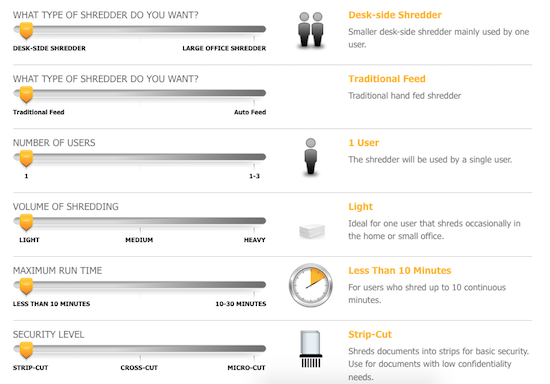
PROFESSIONAL SHREDDING SERVICES
You already know how important it is to shred the papers that you no longer need for tax, legal, or proof-of-ownership purposes; merely tossing them in the trash could make you a quick victim of identity theft. But you also know that once your shred pile is as tall as the youngest of your tax-deductible dependents, your home-rated shredder is likely to wimp out before you get through your seasonal pile shredding.
If you lack the time, space, shredding power, or intestinal fortitude to conquer your backlog of shredding, you have a variety of options for getting professional help. A number of companies are available nationwide to help with document destruction, including:
You are likely to have local and regional shredding companies at your disposal as well.
If you need help finding shredding services in your area, turn to the International Secure Information Governance & Management AssociationTM (i-SIGMA®) (formerly the National Association for Information Destruction (NAID)).
Search the iSIGMA portal for an interactive map of NAID AAA-certified shredding companies nearest to you. Enter your zip code and the system will provide you with a map and list of document destruction services in your area. You can also narrow your search to filter for different kinds of destruction certifications.
Note: Most shredding services offer a combination of drop-off and secure pick-up services; if your office or organization requires regularly scheduled shredding, you can arrange for periodic pickups.
Many retail locations also have relationships with document destruction services. In these situations, you generally self-serve your papers into a slot in a large, locked container that looks much like the garbage and recycling cans you wheel to the street on trash day; the shredding companies usually do pickups every week–to–two weeks and either shred paper in a specialized truck in the store’s parking lot, or trade out an empty bin and take the full one to their physical operations.
Getting your shredding done in the same parking lot where you pick up your groceries or get your office supplies is convenient (and less labor than shredding piles of paper for yourself), but the cost is likely to be a little more than you’d pay if dealing directly with a document destruction service. Prices typically range from a dollar per pound (when discounted), upward.
Check with your local retail locations to see if, how, and at what price they offer shredding services. Start with:
Note, some locations (such as FedEx Office) will shred paper but will not shred CDs, DVDs, credit cards, non-paper ID cards, 3-ring binders, file folders, or laminated items. If you have multiple non-paper items to shred, call ahead to your local retailers to verify what they will shred.
Before you head out, be sure to check the retailers’ sites for discounts, or use your favorite search engine to search “[store name] shredding coupon 2024” to see what discounts are currently available.
Office Depot tends to change discount offerings each month. Right now, Office Depot is offering 5 pounds of in-store shredding for free and 20% off any one-time shredding pick-up service. Both offers expire April 27, 2024. To get the actual scannable coupons barcodes, scroll to the bottom of the Office Depot shredding page and present the coupons on your device at time of sale.
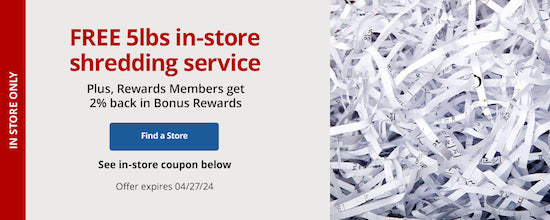
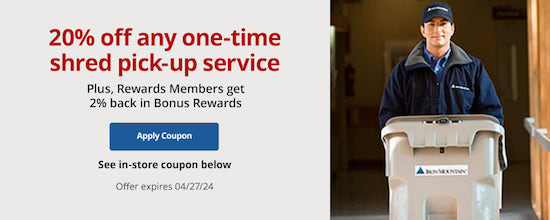
(And sigh, no, I don’t think the fella in the above picture is include in Office Depot’s serivce.)
Staples doesn’t appear to be offering any consumer-based shredding discounts right now, but you can be a hero at your office if you point out Staples’ Iron Mountain 10% off discounts fro one-time shredding of 1 to 21 full-sized bins.
FREE SHREDDING EVENTS
Throughout the year, various government agencies, banks and credit unions, community groups, senior centers, houses of worship, universities partner, and AARP partner with shredding companies for free events billed as shredathons and shred days. In particular, watch for Better Business Bureau-affiliated shredding events associated with tax time and Secure Your ID Day. (Dates vary by region.)
Document destruction companies (like Iron Mountain, Shred-It, Pro-Shred, and Shred Nations) bring their giant paper-chomping trucks to specified parking lots so you can get your papers securely shredded on-site.
Tax time is the perfect opportunity to clear out your file folders, your desk drawers, your purses, wallets, and pockets, and to shred all those random receipts and documents that you don’t need to support your tax returns, keep you legal, or prove ownership of your stuff.
Of course, if you don’t know what you need to keep vs. what you should shred, Paper Doll has you covered with Do I Have To Keep This Piece of Paper?
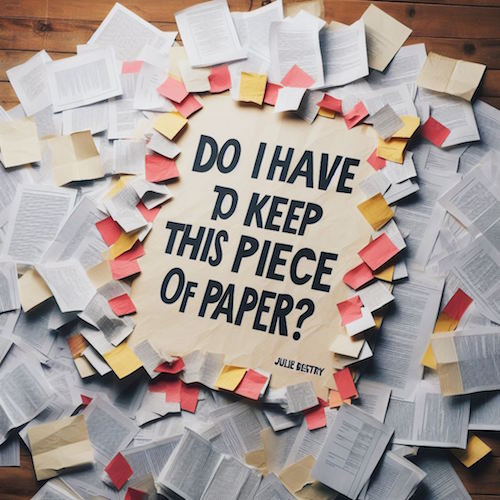
Whether you shred at home or work, use a service, or attend a shredding event, plan time in your schedule to shred. Declutter, protect your identity, and save time and money!




Julie, you really put me to shame here, with approximately ten times as much valuable information as I included in my post, How to Choose the Right Paper Shredder! Maybe that’s why you’re the Paper Doll!
LOL. I just love anything to do with paper, and picking the right shredding option just isn’t as easy as we might think. But thank you for your kind words; between our two posts, people should be well prepared to fight the shredding war!
You have the best sense of humor and found ways to make shredding and shredder selection funny. I loved your “not my first shredding rodeo” comment.
We had a loyal shredder for over 10 years until one day it stopped turning on. There were no loud sounds or creaks, just a definitive, “I’m DONE!” It had been an excellent shredder for us. My husband researched and we ended up purchasing the newer model of the one we had. It’s the Fellowes 79Ci with 16-page capacity.
If I’m doing year-end paper shredding, I will run into that cool down issue. After a while, the shredder needs a break. Not so bad, because it forces me to take one, too, as it gets back to OK shredder temperature.
I love that Shredder Selection tool! Who knew?
While our town runs about three or four free shredder events a year, we also have access to a county recycling. You’re allowed to bring up to four bankers boxes of shredding at a time to shred for free. You can watch it happen as they shred, which is a great feature.
Until my most recent shredder, I’d always had Fellowes branded shredders; they are usually dependable and fairly priced. The one I have now was certainly a coupon code-based decision and it serves my needs, but I have to admit, I’m always envious when I’m at a client with a big corporate office. Those high-powered, high-capacity shredders are so quiet (comparatively) and easy to deal with without muss or fuss!
I always seem to miss the shred-a-thons because they are generally scheduled for mornings, and Paper Doll doesn’t DO mornings! 😉
I spent most of COVID shredding. My husband loves keeping paper, and I was trying to go back and clear out stuff we had that we didn’t need. To be honest, enough time has passed that I have a couple of years worth to go back and look at again!
My feeling was that a good shredder is worth the money if you are going to do any significant amount of shredding. I don’t know the name of ours (and I can’t look now, because my husband is working in the office on a call).
What I do know is that it chopped the paper up into tiny, tiny bits, and would work well for about 10 minutes, and then need to cool down. I found that actually worked for me, because I didn’t want to sit there shredding for hours at a time. I kept a basket of stuff to shred and just went in and worked for a window and then walked away and let it cool off.
Recently, we wanted to shred some old hard drives and internal computer parts. My husband found a place in an industrial complex and loved that he could just pop over there. It really opened up our ability to move forward on a project that had been hanging around. (FYI, he had very specific ideas about what would be “secure,” and wasn’t interested in input from me LOL!)
I think you found the key; concerted progress on your shredding without getting bogged down in it. I have some clients who live in rural areas, and they don’t bother shredding anything; they just have bonfires periodically to burn their papers. Anything more flame-y than a birthday candle and I’m OUT, so that wouldn’t work for me, but tiny bouts of shred time sounds like a perfect way to work through your backlog. Good job!
The shredding companies are definitely the way to go if you want to destroy hard drives. Let your husband have his way and then he doesn’t get to complain later. 😉
Thank you for reading!
I’m with you! Don’t buy a mini shredder. I was an executor for my parents’ estates and needed a powerful shredder. One broke after finishing my dad’s estate. =0 It went on for about 3 weeks, almost every day for at least an hour or two. It was a lot. So, I knew it was a great bargain. So, when my mom passed a few years later, I purchased the same large shredder and still love it.
Regarding the local paid shredding services, I have the ones you mentioned above in my area and some popular local ones. It’s important to shop around. Some were secure, had better customer service, and were more affordable.
We are in sync on this issue. The tiny shredders are adorable but useless. I’ve had client situations where it made sense to just have a mobile shredding company come to the house, process everything there to tiny bits right there in the driveway, and get the document of destruction. For smaller boxes, shlepping to the shredding companies is reasonable. I find that clients who rarely have shredding can get away with going to a Big Box store to shred the equivalent of two or three reams of paper; more than that, a shredding company (or shred-a-thon) is best. But if they have regular shredding to do, or an office, getting your own shredder and working in small doses really is the solution.
Thanks for reading and weighing in.
I don’t have a shredder. Yikes!! What I have is a shredding service. I use a service which comes once a month and shreds papers at my house. No. It’s not just for me. I remove any papers that must be shredded from my clients’ homes. This saves my clients from having to spend the time shredding the papers we have already removed from files and/or piles.
If I were to buy a shredder, I believe it’s important to get one that shreds multiple pages at once and is a cross-cut shredder.
Your review is terrific – with tons of valuable information and humor peppered in!
A shredding service definitely makes sense — and since it’s part of your business, it’s a tax-deductible expense. Double-win!
Thank you for reading and I’m delighted my goofy humor comes across.
It is amazing you can make an article on shredding so engaging and fun. Thanks for bringing a sense of humour to shredding. As I read the post I think I have encountered personally or with clients every situation you wrote about. I agree that small ones that need to be emptied often stop being used quickly and become clutter. I was surprised to learn that some shredders for home office use can handle 10 sheets at a time. I like my shredder but it doesn’t handle multiple sheets well especially as the canister gets fuller. If they could make a shredder that was noiseless that would be great. I think the most important factor about a shredder is where it is located. If it is not easy to access it doesn’t get used. So perhaps the size you purchase should be influenced by the space you are going to put it in.
Aw, Julie, thank you for your kind words. I figure if I make a post fun for me to write, there’s a good chance it will be fun for the reader. I really appreciate you reading and saying this.
You are so right; if there’s friction, people won’t use the shredder. It needs to be where the paper is. Every time I move it from my desk-side to somewhere less physically inconvenient, I put off shredding, and I’m sure it’s the same for clients. And someday, perhaps, we’ll have whisper-quiet shredders!
I never thought I could enjoy reading an article about shredding, you make it really smooth and fun. Reading the comments, I think having a service come to your house to shred a big amount of papers is a great idea for some of our clients that don’t trust going anywhere with their valuable documents and papers.
Around tax time, like you mentioned, we do have a huge box with papers and documents that we will be taking to a shredding event. I like that they have the different ones for different items, like computer parts, electronics etc.
Thank you; if you found it fun, I did my job! And I agree; unlike Diane, I’ve never had a service come to my office, but I have arranged on-site shredding for clients with excess paper and it worked out well for them. It’s not inexpensive, but it solves a problem quickly and completely.
I appreciate you reading and commenting!